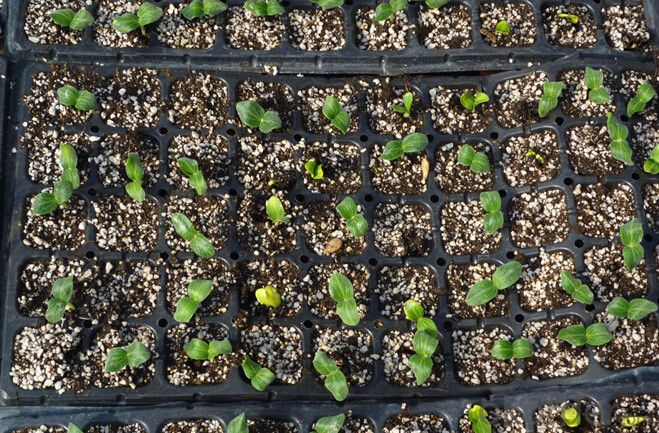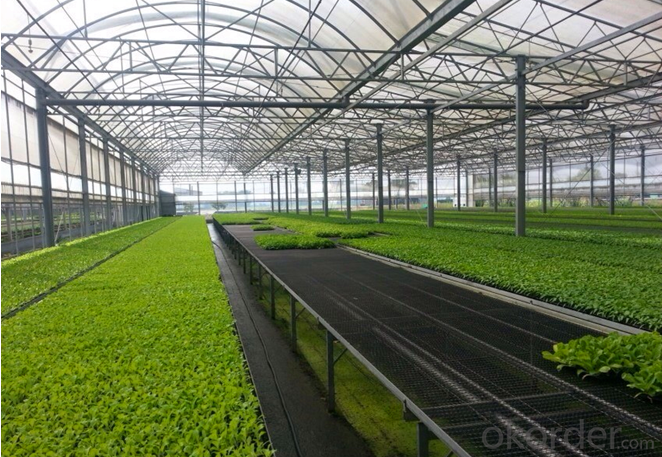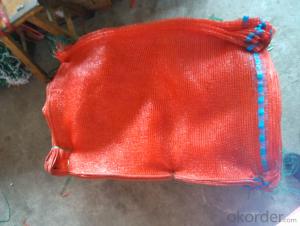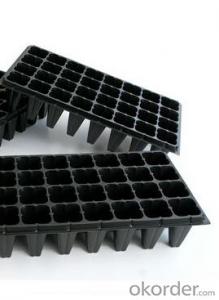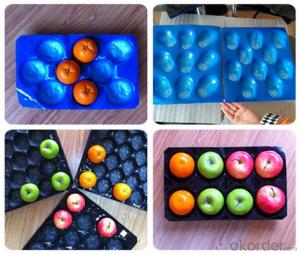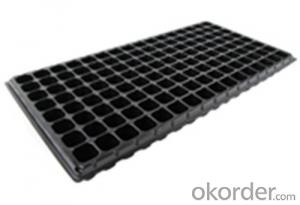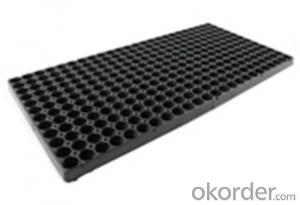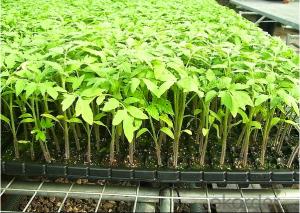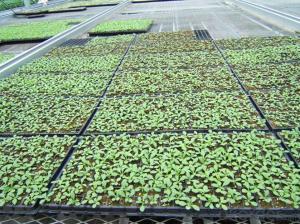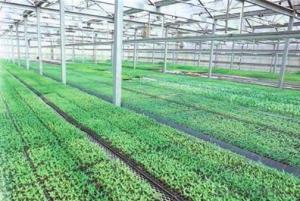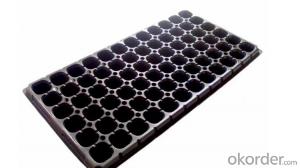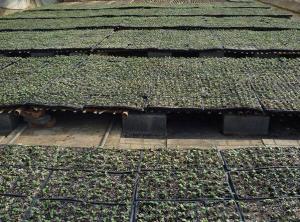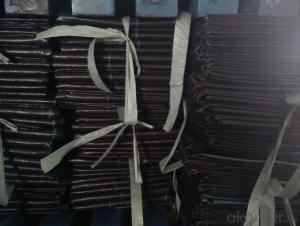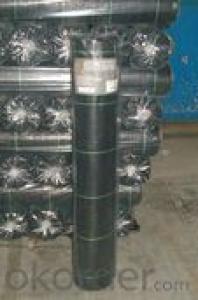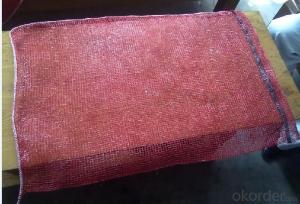Greenhouse Usage Plug Trays (Growing and Seedling) HIPS Made Plastic Seed Tray
- Loading Port:
- China main port
- Payment Terms:
- TT OR LC
- Min Order Qty:
- 3000 pc
- Supply Capability:
- 50000 pc/month
OKorder Service Pledge
OKorder Financial Service
You Might Also Like
Brief Introduction to CNBM:
CNBM International Corporation (CNBM International) is the most important trading platform of CNBM Group Corporation, a state-owned company under the direct supervision of State-owned Assets Supervision and Administration Commission of the State Council.
CNBM International is highly recognized by its business partners and clients all over the world and has obtained rapid development under the spirit of win-win. We will carry on the mutual beneficial, innovative and revolutionary trading structure as we did before, create value for our employees, share holders and clients and benefit the whole society in our future development.
Features of Plug Trays (Growing and Seedling) HIPS Made Plastic Plug Tray for Greenhouse:
· Material: HIPS
· Thickness: 0.5mm-1.5mm, Standard:1mm
· Weight: 80g(±5)g-230g(±5)g, Standard weight:155g(±5)g
· Size: length:490mm-540mm, width:190mm-345mm,depth:25mm-150mm
· Standard:540mmX280mm
· Cell count: 18-512
· Package: In Carton
· Warrenty: 8-10 times
Picture:

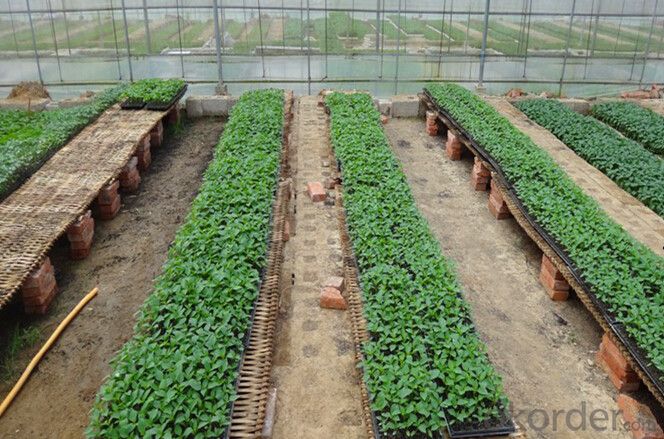
Specification of Plug Trays (Growing and Seedling) HIPS Made Plastic Plug Tray for Greenhouse:
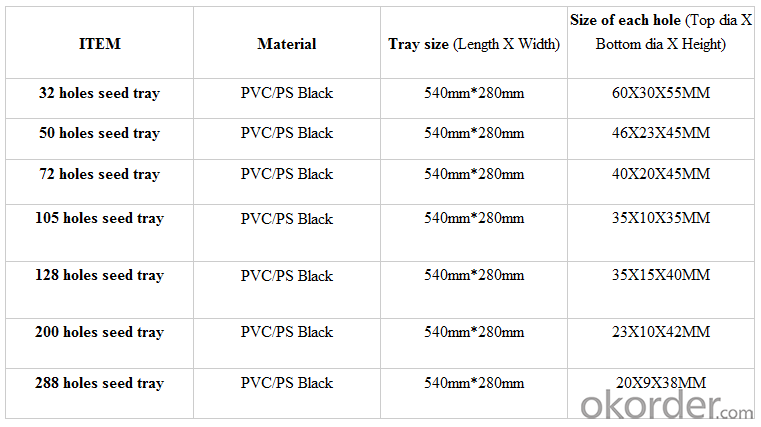
FAQ of Plug Trays (Growing and Seedling) HIPS Made Plastic Plug Tray for Greenhouse:
Q:1.How many times can the seed tray be used?
A: Under the same environment, it is decided by the thickness. Usually 0.6mm thickness can be used for 1 or 2 times.
1.0 thickness can be used for 3-4 times. 1.5 thickness can be used for 8-10 times.
Q: 2.How long is the production time?
A: Usually one to two weeks.
Q: 3.How is the seed tray being packaged?
A: They can be packaged in carton or pallets. Carton size is 1375px*725px*1250px.
- Q: is it a type of plastic ..if not what is it ?
- Yes, Thermocol is a plastic. It's polystyrene. Polystyrene is a polymer made from the monomer styrene, a liquid hydrocarbon that is commercially manufactured from petroleum. At room temperature, polystyrene is normally a solid thermoplastic, but can be melted at higher temperature for molding or extrusion, then resolidified. Styrene is an aromatic monomer, and polystyrene is an aromatic polymer.
- Q: What are some ground cover options for areas with high rainfall?
- Some ground cover options for areas with high rainfall include ferns, mosses, creeping thyme, ajuga, and vinca minor. These plants are well-adapted to moist conditions and can help prevent erosion while adding aesthetic value to the area.
- Q: This question asks about the methods farmers employ to decrease their environmental impact by using agricultural plastic products.
- <p>Farmers can reduce their carbon footprint using agricultural plastic products through several strategies. One is by using biodegradable plastics, which break down naturally and emit fewer greenhouse gases. They also use mulch films to reduce soil erosion and water evaporation, conserving water and reducing the need for irrigation. Additionally, plastic greenhouses help in maintaining optimal growing conditions, reducing the need for energy-intensive heating or cooling. Proper recycling and disposal of used plastics also play a significant role in minimizing environmental impact. By integrating these practices, farmers can make their operations more sustainable and eco-friendly.</p>
- Q: Can ground cover be used to create a natural-looking border around a pond or water feature?
- Yes, ground cover can definitely be used to create a natural-looking border around a pond or water feature. Ground cover plants, such as creeping thyme, sedum, or pachysandra, can help soften the edges of the pond or water feature, provide a seamless transition between the water and surrounding landscape, and create a visually appealing and cohesive natural border. These low-growing plants also help to prevent soil erosion and filter water runoff, contributing to the overall health and sustainability of the pond or water feature ecosystem.
- Q: Are nursery trays suitable for starting vegetable seeds indoors?
- Yes, nursery trays are suitable for starting vegetable seeds indoors. They provide a controlled environment for seed germination and growth, allowing for better moisture retention and temperature regulation. Additionally, the individual cells in nursery trays help prevent root entanglement between different seedlings, promoting healthier growth.
- Q: Can nursery trays be used for starting herb seeds?
- Yes, nursery trays can be used for starting herb seeds. They provide a convenient and organized way to germinate and grow multiple herb seedlings at once. The trays typically have individual compartments that allow for easy transplanting once the seedlings have developed.
- Q: I need at least three chemical reactions used during the process of making plastic. I don't care what part, but I need the total balanced equation.
- You need to decide what kind of plastic you are making, so you can identify your raw materials. Are you making a plastic using formaldehyde and urea? (this is actually a common plastic). Are you making a plastic using ethylene oxide? Are you making an epoxy? Then you can search the web for the chemical reactions.
- Q: This question asks about the methods farmers employ to enhance crop production using plastic mulch film in agriculture.
- <p>Farmers use agricultural plastic mulch film to improve crop yields by creating a barrier that warms the soil, conserves moisture, and suppresses weeds. The film helps to retain heat from the sun, which can lead to earlier planting and a longer growing season. It also reduces water evaporation from the soil surface, conserving water and reducing the need for irrigation. Weed growth is minimized under the film, which means fewer resources are competed for by the crops, and less labor is required for weed control. Additionally, mulch films can improve soil structure and fertility by decomposing into organic matter over time, further enhancing crop growth and yield.</p>
- Q: Ive heard that it is not safe to use clear plastic to cover dishes in the microwave - why? I've also heard that it is not safe to drink left over water in plastic bottles - why? And last, I've heard not to buy drinks in plastic, but glass bottles - why? Do you feel me with the confusion since everything almost is in plastic? I really want people who have a real source of information - no smartie pants please!
- Plastic emits a gas as it is not inert. When you store food in plastic, the gas permeates the food. When you get into your automobile after letting it sit for awhile, you will notice a film that builds up on the inside of your front window. The film is caused by the emission of gas from your dashboard. I always keep one window open about 1/4 to let the gases escape my car when it is parked. The gases emitted by plastic can be hazardous to your health. I have heard in some countries, they are outlawing plastic wrap and containers, for this very reason. Glass is inert - it does not emit a gas, and glass does not change the taste of foods contained in it.
- Q: Can nursery trays be used for starting native plant seeds?
- Yes, nursery trays can be used for starting native plant seeds. Nursery trays provide a convenient and organized way to start seeds, allowing for better control of moisture and temperature. Additionally, they provide adequate space for seedlings to grow before transplanting them into larger containers or the ground.
Send your message to us
Greenhouse Usage Plug Trays (Growing and Seedling) HIPS Made Plastic Seed Tray
- Loading Port:
- China main port
- Payment Terms:
- TT OR LC
- Min Order Qty:
- 3000 pc
- Supply Capability:
- 50000 pc/month
OKorder Service Pledge
OKorder Financial Service
Similar products
Hot products
Hot Searches
Related keywords






